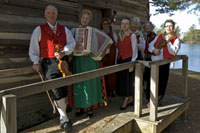MUSICAL CULTURE OF FINLAND AND SCANDINAVIA
FINLAND

The Finnish language is entirely different from the languages of other countries in Scandinavia. Because Finland shares its language origin with Baltic countries, Finnish folk songs have more in common with Baltic folk songs than with other Scandinavian folk songs. Kalavalaic song is the singing of poems about the myths and heroic legends of Finland and is an important part of Finnish folk song tradition.
DENMARK

The ballad is the most common type of Danish folk song. Traditional Danish folk dance instruments include fiddle, drum, clarinet, flute, and harmonica. Contemporary Danish folk singers have used instruments like the guitar in styles similar to those found in other countries.
NORWAY
The most common types of Norwegian folk songs are ballads and songs with religious topics. Norwegians also have an old tradition of calling cattle in a special way that uses shouting, singing, and speaking. These Norskie cattle calls involve wide vocal leaps.

The violin and the Hardanger fiddle are the most important Norwegian folk instruments. The Hardanger fiddle has four melody strings and four or five sympathetic strings. These sympathetic strings lie below the ornately decorated fingerboard, and, although they are not touched by the bow, they still vibrate along with the melody strings. Dance tunes are played on both the traditional violin and the Hardanger fiddle. Norwegians also play a type of zither that dates from before 1600 and is a distant relative of the Appalachian mountian dulcimer. It has one melody string and from three to seven drone strings.SWEDEN
Swedish dairy maids have their own unique cow-calling tradition that involves singing in falsetto. Many Swedish ballads date back as far as the Middle Ages. Other Swedish folk songs include folk hymns and topical songs. They are commonly accompanied by zither or guitar, or sung a cappella.The violin is the most important instrument played for Swedish dances.

The folk songs of Scandinavia are not complicated—they use diatonic scales and triple and duple meter, and the rhythm serves the lyrics, sometimes with dotted rhythms and syncopation, and sometimes with grace notes. These folk songs are about everything from dairy farming and fishing to the "midnight sun" of summer and the dark days of winter. They also tell of scary things in the forest, fairy tales, trolls, religion, history, love of country, and daily life, including love.
